Soviet Lithuanian children’s book illustration (c. 1947–1972) from Illustrarium
![]() Arūnas Tarabilda, Confusion of the Stars, 1963
The images and quotes in this post come from the catalog Illustrarium: Soviet Lithuanian Children’s Book Illustration. Illustrarium was a project dedicated to Lithuania's participation as a guest of honor country at the Bologna Children’s Book Fair in 2011.
Publisher's description: "The catalogue features Soviet Lithuanian children’s book illustrations created between 1945 and 1990. The display in the exhibition and in the catalogue as well has been composed with the aim of evoking a general Soviet-epoch context in Lithuania in which these children’s books were published and showing the most interesting work from Lithuanian artists of the field."
Arūnas Tarabilda, Confusion of the Stars, 1963
The images and quotes in this post come from the catalog Illustrarium: Soviet Lithuanian Children’s Book Illustration. Illustrarium was a project dedicated to Lithuania's participation as a guest of honor country at the Bologna Children’s Book Fair in 2011.
Publisher's description: "The catalogue features Soviet Lithuanian children’s book illustrations created between 1945 and 1990. The display in the exhibition and in the catalogue as well has been composed with the aim of evoking a general Soviet-epoch context in Lithuania in which these children’s books were published and showing the most interesting work from Lithuanian artists of the field."
![]() Arūnas Tarabilda, Confusion of the Stars, 1963
Arūnas Tarabilda, Confusion of the Stars, 1963
![]() Telesforas Kulakauskas, cover for Limpopo: The Adventures of Dr. Aiskauda, 1949
Telesforas Kulakauskas, cover for Limpopo: The Adventures of Dr. Aiskauda, 1949![]() Vaclovas Kosciuška, Two Little Cocks, 1959
Vaclovas Kosciuška, Two Little Cocks, 1959
![]() Vincas Dilka, I'm Not a Tiny Tot Anymore, 1947
"one of the first ideologically charged postwar books for Soviet Lithuanian children"
Vincas Dilka, I'm Not a Tiny Tot Anymore, 1947
"one of the first ideologically charged postwar books for Soviet Lithuanian children"![]() Aspazija Surgailienė, Little Anthony and the Moon, 1960
Aspazija Surgailienė, Little Anthony and the Moon, 1960
![]() Arvydas Každailis, When the Earth Rises, 1967
"The artist combined elements of Polish children's book illustrations with his own impressions of paintings by Paul Klee which made a huge impact on him."
Arvydas Každailis, When the Earth Rises, 1967
"The artist combined elements of Polish children's book illustrations with his own impressions of paintings by Paul Klee which made a huge impact on him."
![]() Albina Makunaitė, The Liberator of the Sun, 1959
"accepted in Lithuania as a groundbreaking example, proving the possibility of rejecting Socialist Realism and modernizing graphic art using the principles of primitive art (in this case, Lithuanian folk art). The book was translated into several languages, including Swahili."
Albina Makunaitė, The Liberator of the Sun, 1959
"accepted in Lithuania as a groundbreaking example, proving the possibility of rejecting Socialist Realism and modernizing graphic art using the principles of primitive art (in this case, Lithuanian folk art). The book was translated into several languages, including Swahili."
![]() Arvydas Každailis, Thank You Rogue Stone, 1963
Arvydas Každailis, Thank You Rogue Stone, 1963
![]() Birutė Žilytė, The Golden Sieve, 1967
Also see: The Brave Girl from Vilnius and Greenbeard the Killer
Birutė Žilytė, The Golden Sieve, 1967
Also see: The Brave Girl from Vilnius and Greenbeard the Killer
![]() Vytautas Valius, "The Gnomes and the Music," for the children's magazine Genys, 1967
Vytautas Valius, "The Gnomes and the Music," for the children's magazine Genys, 1967![]() Arūnas Tarabilda, Journey to the Ditch, 1961
Arūnas Tarabilda, Journey to the Ditch, 1961
![]() Vladislovas Zilius, Vai tai duda, 1972
Vladislovas Zilius, Vai tai duda, 1972![]() Algirdas Steponavičius, The Frog Queen, 1962
Someday I'll do a full post on this book, which I've owned for a few years. It was "one of the most popular books in Soviet Lithuania, loved by children and their parents, and recognized by professionals." It won many awards.
"My pictures are not straightforward illustrations to the text; rather, they are universal artistic structures speaking about being. The plots of the fairy tales are not really important, they are immersed in the lurking shapes."—Algirdas Steponavičius
Algirdas Steponavičius, The Frog Queen, 1962
Someday I'll do a full post on this book, which I've owned for a few years. It was "one of the most popular books in Soviet Lithuania, loved by children and their parents, and recognized by professionals." It won many awards.
"My pictures are not straightforward illustrations to the text; rather, they are universal artistic structures speaking about being. The plots of the fairy tales are not really important, they are immersed in the lurking shapes."—Algirdas Steponavičius
![]() Algirdas Steponavičius, "The Wolf's Friendship" in Genys magazine, 1967
Algirdas Steponavičius, "The Wolf's Friendship" in Genys magazine, 1967
![]() Algirdas Steponavičius, "The Monstrous Vacuum Cleaner," for Genys magazine, 1967
Algirdas Steponavičius, "The Monstrous Vacuum Cleaner," for Genys magazine, 1967
![]() Ieva Naginskaitė, What the Scissors Did, 1961
"The only interactive Lithuanian children's book of the 1960s..."
Ieva Naginskaitė, What the Scissors Did, 1961
"The only interactive Lithuanian children's book of the 1960s..."
![]() Teodora Každailienė, Where the Ships Hoot, 1970
Teodora Každailienė, Where the Ships Hoot, 1970
![]() Lidija Glinskiene, Iron Fingernails, 1968
Lidija Glinskiene, Iron Fingernails, 1968![]() Lidija Glinskiene, Leine the Warrior, 1965
Lidija Glinskiene, Leine the Warrior, 1965![]() Aspazija Surgailienė, The Chest of Fairy Tales, 1961
Aspazija Surgailienė, The Chest of Fairy Tales, 1961
![]() Marija Ladigaitė, The Four Winds of Winter, 1963
"These illustrations are remarkable, not only for their modern form, but also for the intense mood of overwhelming sadness..."
Marija Ladigaitė, The Four Winds of Winter, 1963
"These illustrations are remarkable, not only for their modern form, but also for the intense mood of overwhelming sadness..."
![]() Kastytis Skromanas, Our Soliders, 1971
"An example of Soviet military propaganda..."
Kastytis Skromanas, Our Soliders, 1971
"An example of Soviet military propaganda..."![]() Rimtautas Gibavičius, Little Pieces of Amber, 1961
Rimtautas Gibavičius, Little Pieces of Amber, 1961
![]() Marija Ladigaitė, The Little Owl's Dream, 1969
Marija Ladigaitė, The Little Owl's Dream, 1969
![]() Lidija Glinskiene, Little Fire, Conqueror of the Seven, 1965
Lidija Glinskiene, Little Fire, Conqueror of the Seven, 1965![]() Arvydas Každailis, Our Cars, 1972
About the exhibit:The exhibits reveal what ideas and images were instilled in little readers, how they served the dissemination of Communist ideology and to what extent children were allowed to live in the child’s world of fairy tales, adventures and imagination.
The exhibition is broken into three parts corresponding to the three main stages in the history of Soviet Lithuania. The exhibits are arranged chronologically and according to four themes: the children’s book as a mouthpiece for propaganda, the children’s book as a means of sustaining the national identity, the children’s book as a “window to the West”, and the child’s world as it emerges in the illustration of children’s books. Originals of books and illustrations are on view, while the catalogue includes photographs from the period reflecting the lives of children and the atmosphere, and posters which accompanied children’s cultural life.
All Lithuanians who experienced a Soviet childhood keep memories of the legendary pair of artists Birutė Žilytė and Algirdas Steponavičius. Today we can discover a new relevance in work by artists who established themselves in the 1960s and 1970s. Steponavičius is the key to understanding the artistic world of the entire generation of contemporary book illustrators. He set a standard for the most talented of his generation and younger Lithuanian graphic artists such as Lidija Glinskienė, Petras Repšys, Aspazija Surgailienė. He was indirectly a teacher for Stasys Eidrigevičius, who matured as an artist in Lithuania before continuing his career after 1980 in Poland. Žilytė, Steponavičius, their contemporaries and younger artists represented the entire epoch of Lithuanian culture which emerges in this exhibition.
Thanks again to Rūta for her help! Also to Laura at Animalarium for turning me on to Illustrarium in 2011.
See all posts tagged "Lithuania"
This post first appeared on March 24, 2014 on 50 Watts
Arvydas Každailis, Our Cars, 1972
About the exhibit:The exhibits reveal what ideas and images were instilled in little readers, how they served the dissemination of Communist ideology and to what extent children were allowed to live in the child’s world of fairy tales, adventures and imagination.
The exhibition is broken into three parts corresponding to the three main stages in the history of Soviet Lithuania. The exhibits are arranged chronologically and according to four themes: the children’s book as a mouthpiece for propaganda, the children’s book as a means of sustaining the national identity, the children’s book as a “window to the West”, and the child’s world as it emerges in the illustration of children’s books. Originals of books and illustrations are on view, while the catalogue includes photographs from the period reflecting the lives of children and the atmosphere, and posters which accompanied children’s cultural life.
All Lithuanians who experienced a Soviet childhood keep memories of the legendary pair of artists Birutė Žilytė and Algirdas Steponavičius. Today we can discover a new relevance in work by artists who established themselves in the 1960s and 1970s. Steponavičius is the key to understanding the artistic world of the entire generation of contemporary book illustrators. He set a standard for the most talented of his generation and younger Lithuanian graphic artists such as Lidija Glinskienė, Petras Repšys, Aspazija Surgailienė. He was indirectly a teacher for Stasys Eidrigevičius, who matured as an artist in Lithuania before continuing his career after 1980 in Poland. Žilytė, Steponavičius, their contemporaries and younger artists represented the entire epoch of Lithuanian culture which emerges in this exhibition.
Thanks again to Rūta for her help! Also to Laura at Animalarium for turning me on to Illustrarium in 2011.
See all posts tagged "Lithuania"
This post first appeared on March 24, 2014 on 50 Watts
![]()
![]()
![]()
 Arūnas Tarabilda, Confusion of the Stars, 1963
The images and quotes in this post come from the catalog Illustrarium: Soviet Lithuanian Children’s Book Illustration. Illustrarium was a project dedicated to Lithuania's participation as a guest of honor country at the Bologna Children’s Book Fair in 2011.
Publisher's description: "The catalogue features Soviet Lithuanian children’s book illustrations created between 1945 and 1990. The display in the exhibition and in the catalogue as well has been composed with the aim of evoking a general Soviet-epoch context in Lithuania in which these children’s books were published and showing the most interesting work from Lithuanian artists of the field."
Arūnas Tarabilda, Confusion of the Stars, 1963
The images and quotes in this post come from the catalog Illustrarium: Soviet Lithuanian Children’s Book Illustration. Illustrarium was a project dedicated to Lithuania's participation as a guest of honor country at the Bologna Children’s Book Fair in 2011.
Publisher's description: "The catalogue features Soviet Lithuanian children’s book illustrations created between 1945 and 1990. The display in the exhibition and in the catalogue as well has been composed with the aim of evoking a general Soviet-epoch context in Lithuania in which these children’s books were published and showing the most interesting work from Lithuanian artists of the field."
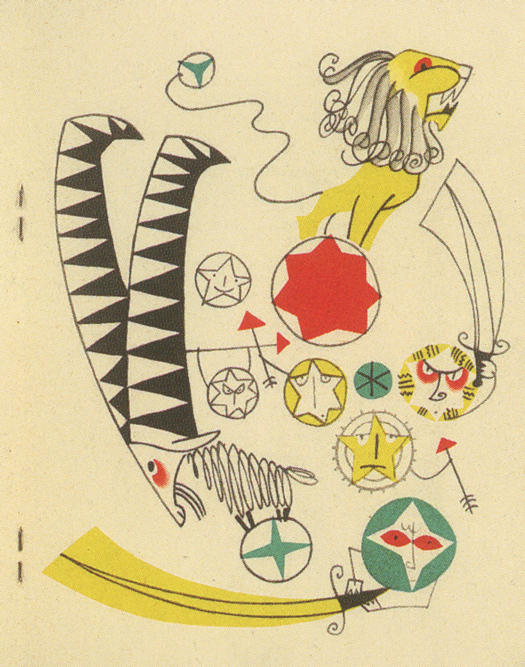 Arūnas Tarabilda, Confusion of the Stars, 1963
Arūnas Tarabilda, Confusion of the Stars, 1963
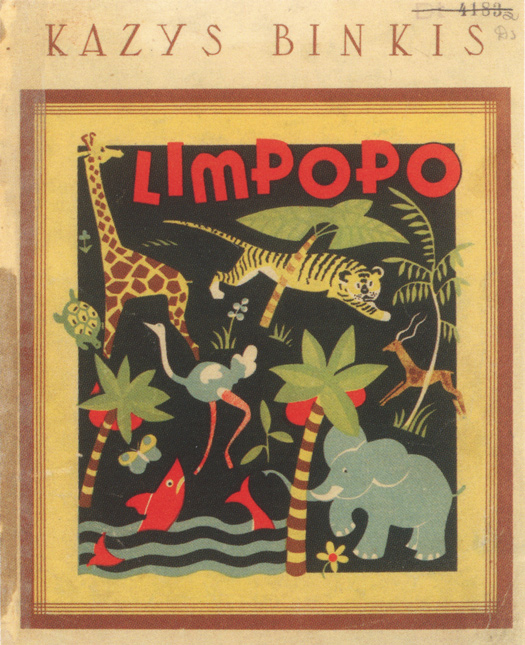 Telesforas Kulakauskas, cover for Limpopo: The Adventures of Dr. Aiskauda, 1949
Telesforas Kulakauskas, cover for Limpopo: The Adventures of Dr. Aiskauda, 1949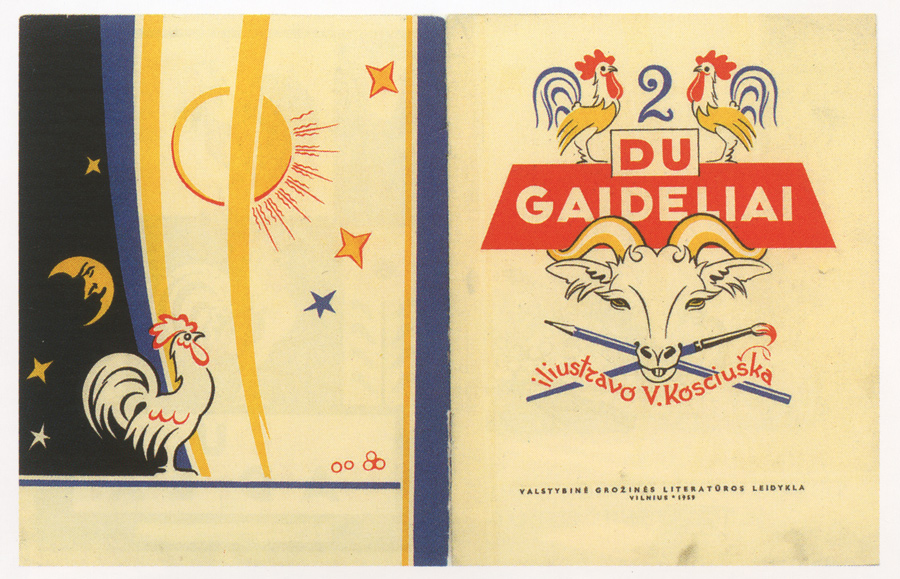 Vaclovas Kosciuška, Two Little Cocks, 1959
Vaclovas Kosciuška, Two Little Cocks, 1959
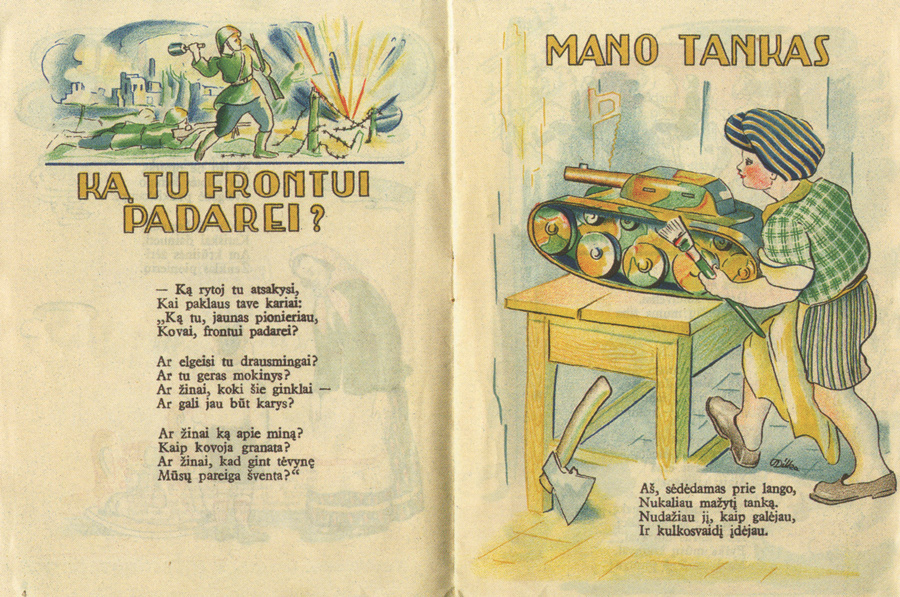 Vincas Dilka, I'm Not a Tiny Tot Anymore, 1947
"one of the first ideologically charged postwar books for Soviet Lithuanian children"
Vincas Dilka, I'm Not a Tiny Tot Anymore, 1947
"one of the first ideologically charged postwar books for Soviet Lithuanian children"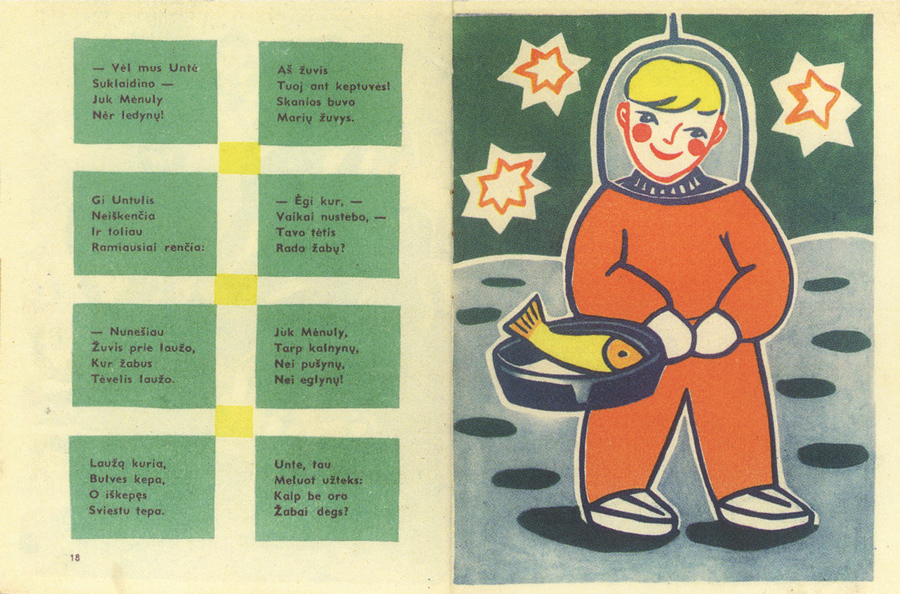 Aspazija Surgailienė, Little Anthony and the Moon, 1960
Aspazija Surgailienė, Little Anthony and the Moon, 1960
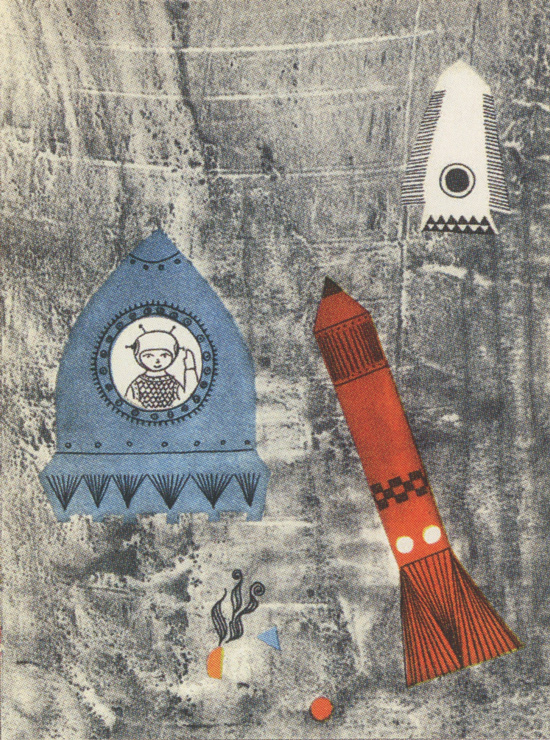 Arvydas Každailis, When the Earth Rises, 1967
"The artist combined elements of Polish children's book illustrations with his own impressions of paintings by Paul Klee which made a huge impact on him."
Arvydas Každailis, When the Earth Rises, 1967
"The artist combined elements of Polish children's book illustrations with his own impressions of paintings by Paul Klee which made a huge impact on him."
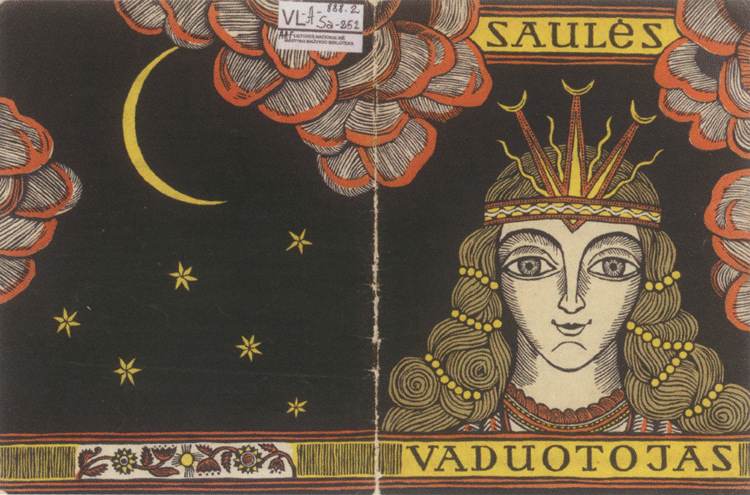 Albina Makunaitė, The Liberator of the Sun, 1959
"accepted in Lithuania as a groundbreaking example, proving the possibility of rejecting Socialist Realism and modernizing graphic art using the principles of primitive art (in this case, Lithuanian folk art). The book was translated into several languages, including Swahili."
Albina Makunaitė, The Liberator of the Sun, 1959
"accepted in Lithuania as a groundbreaking example, proving the possibility of rejecting Socialist Realism and modernizing graphic art using the principles of primitive art (in this case, Lithuanian folk art). The book was translated into several languages, including Swahili."
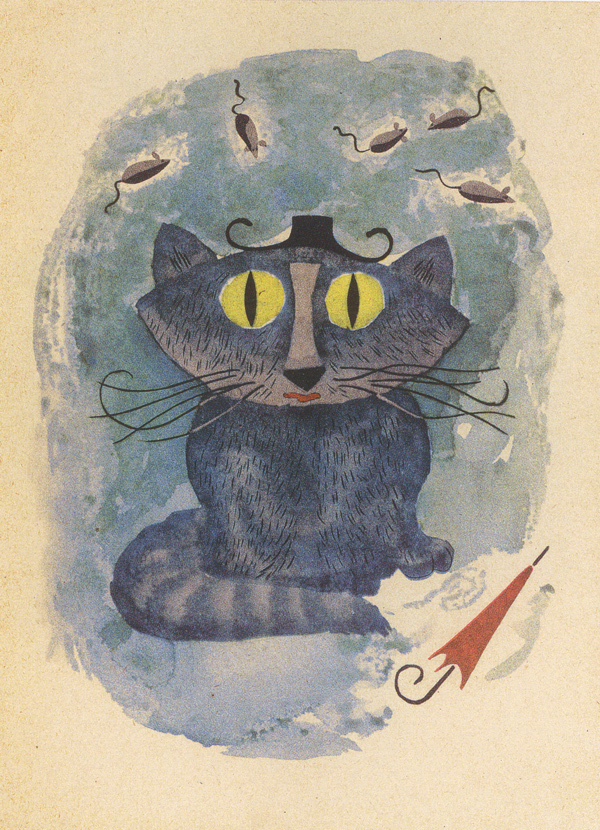 Arvydas Každailis, Thank You Rogue Stone, 1963
Arvydas Každailis, Thank You Rogue Stone, 1963
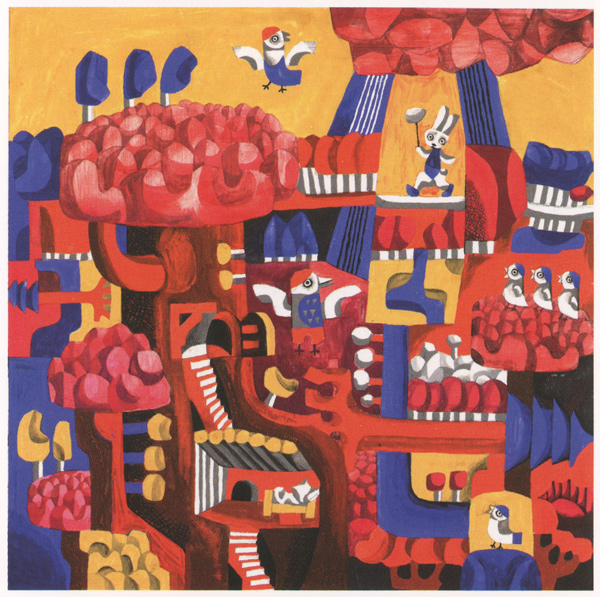 Birutė Žilytė, The Golden Sieve, 1967
Also see: The Brave Girl from Vilnius and Greenbeard the Killer
Birutė Žilytė, The Golden Sieve, 1967
Also see: The Brave Girl from Vilnius and Greenbeard the Killer
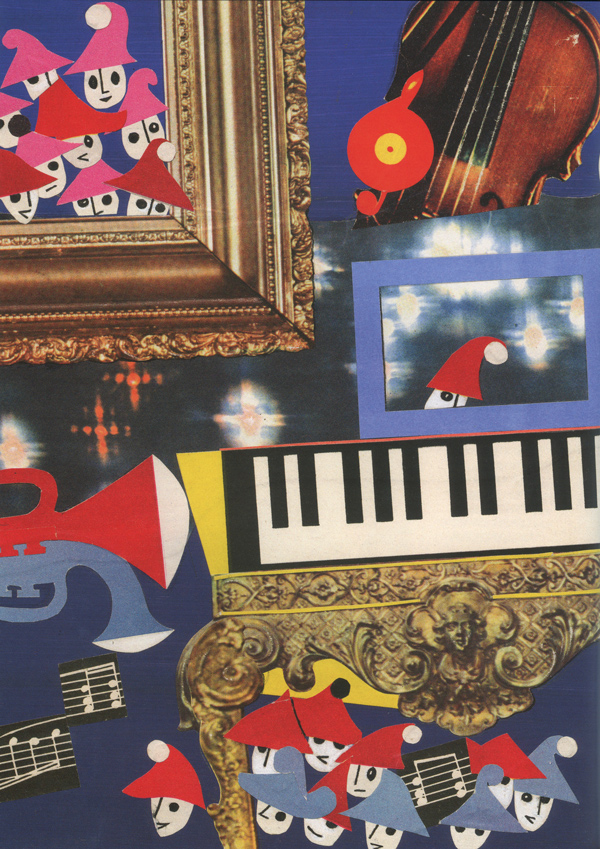 Vytautas Valius, "The Gnomes and the Music," for the children's magazine Genys, 1967
Vytautas Valius, "The Gnomes and the Music," for the children's magazine Genys, 1967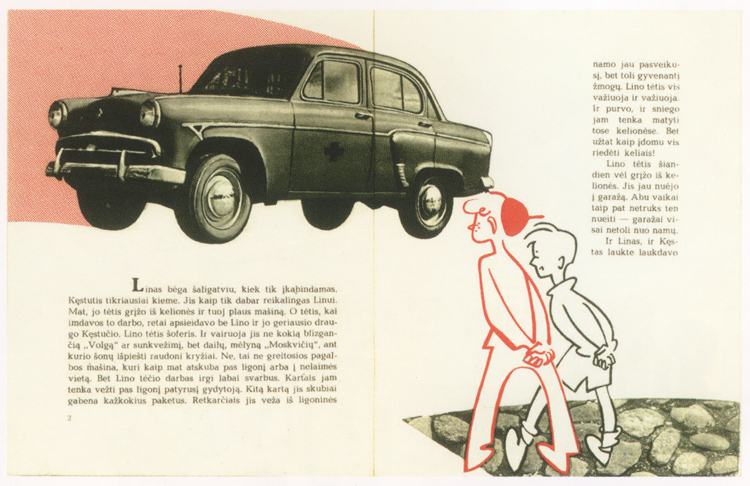 Arūnas Tarabilda, Journey to the Ditch, 1961
Arūnas Tarabilda, Journey to the Ditch, 1961
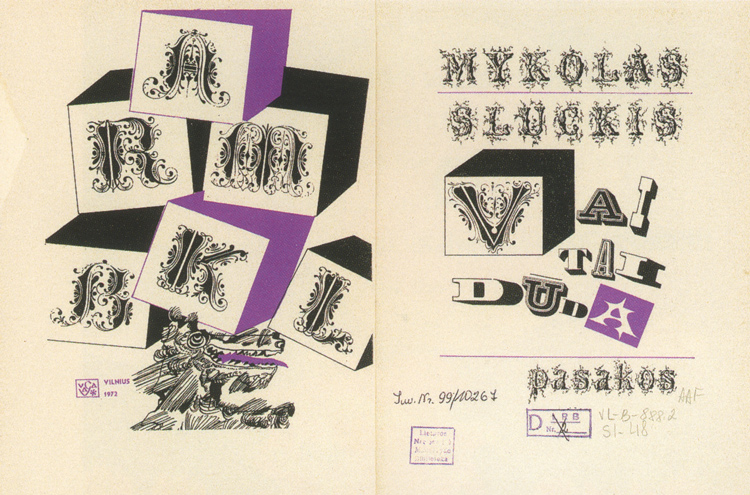 Vladislovas Zilius, Vai tai duda, 1972
Vladislovas Zilius, Vai tai duda, 1972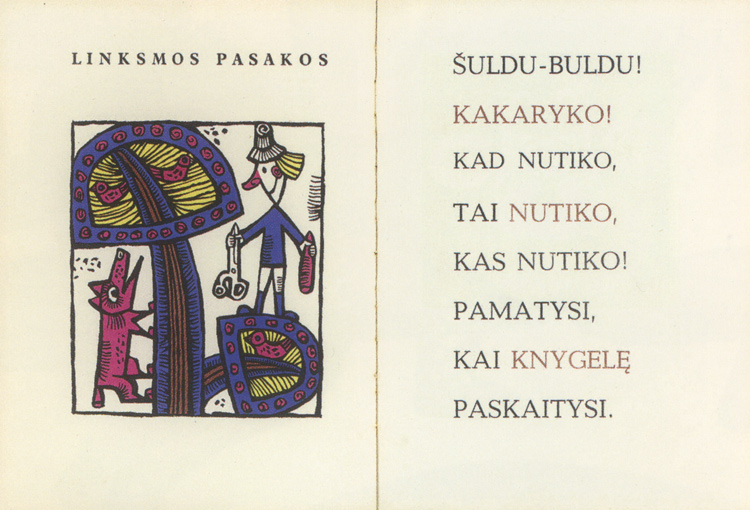 Algirdas Steponavičius, The Frog Queen, 1962
Someday I'll do a full post on this book, which I've owned for a few years. It was "one of the most popular books in Soviet Lithuania, loved by children and their parents, and recognized by professionals." It won many awards.
"My pictures are not straightforward illustrations to the text; rather, they are universal artistic structures speaking about being. The plots of the fairy tales are not really important, they are immersed in the lurking shapes."—Algirdas Steponavičius
Algirdas Steponavičius, The Frog Queen, 1962
Someday I'll do a full post on this book, which I've owned for a few years. It was "one of the most popular books in Soviet Lithuania, loved by children and their parents, and recognized by professionals." It won many awards.
"My pictures are not straightforward illustrations to the text; rather, they are universal artistic structures speaking about being. The plots of the fairy tales are not really important, they are immersed in the lurking shapes."—Algirdas Steponavičius
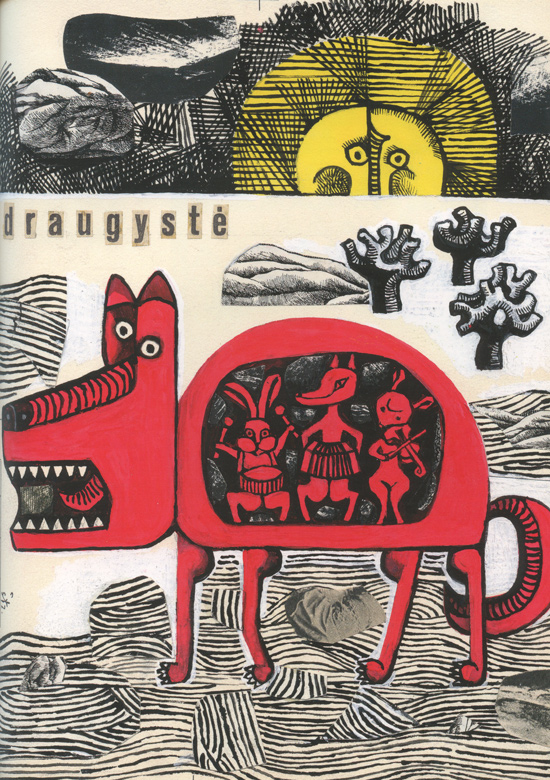 Algirdas Steponavičius, "The Wolf's Friendship" in Genys magazine, 1967
Algirdas Steponavičius, "The Wolf's Friendship" in Genys magazine, 1967
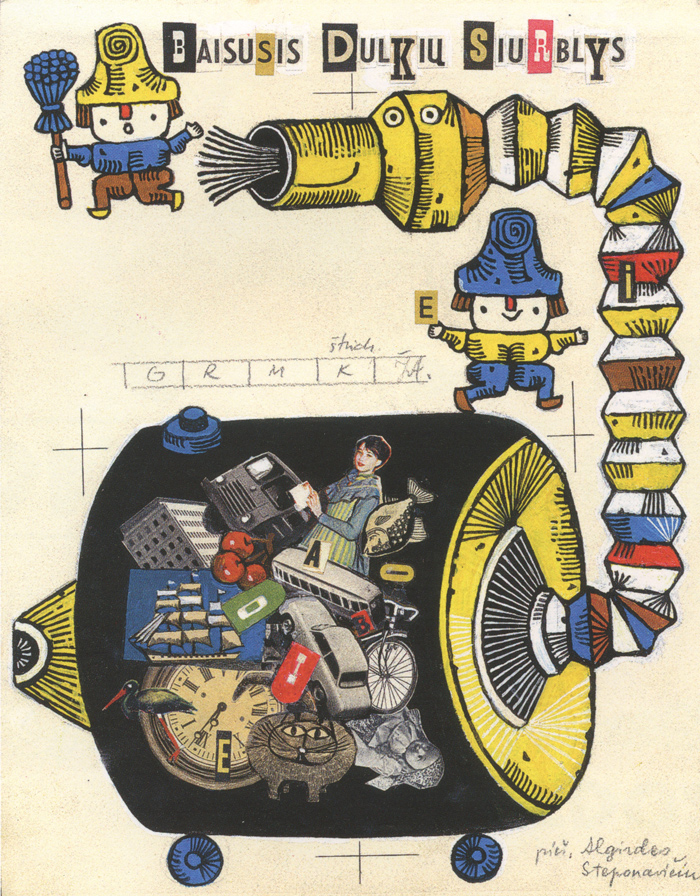 Algirdas Steponavičius, "The Monstrous Vacuum Cleaner," for Genys magazine, 1967
Algirdas Steponavičius, "The Monstrous Vacuum Cleaner," for Genys magazine, 1967
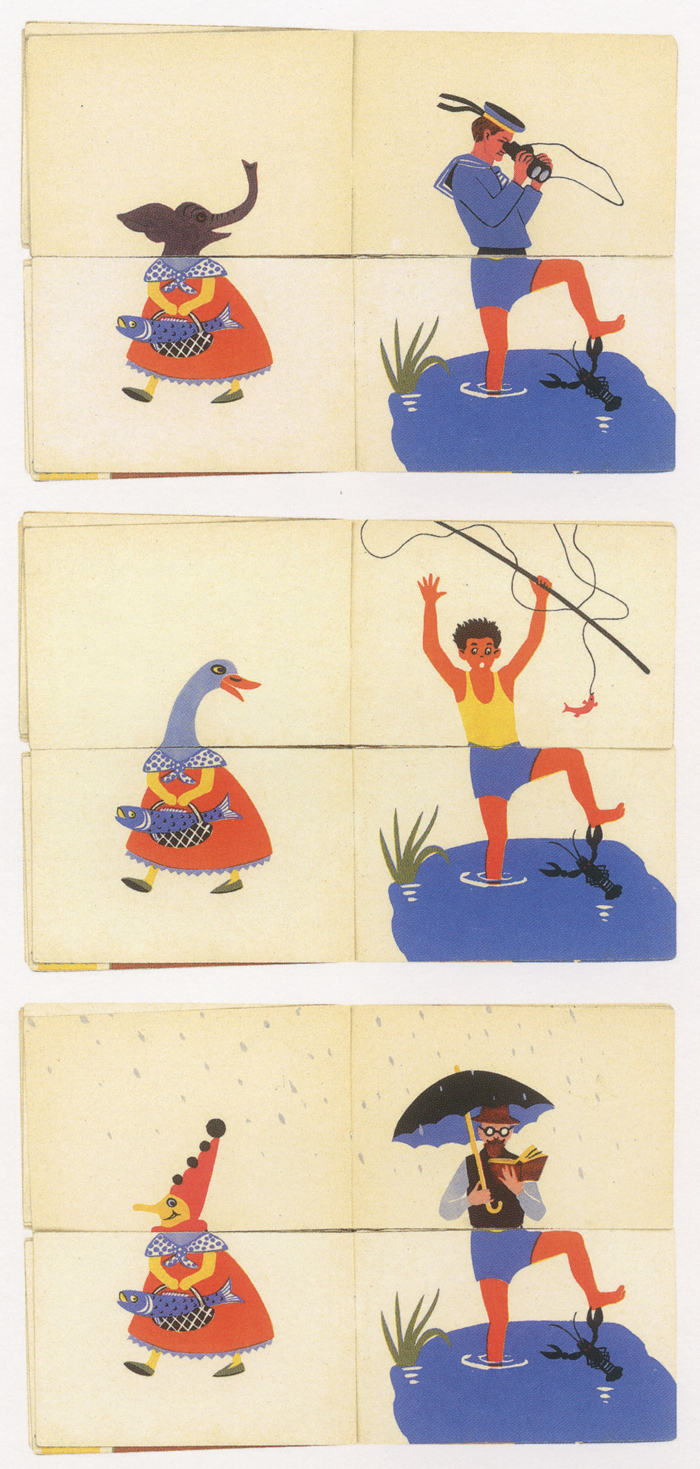 Ieva Naginskaitė, What the Scissors Did, 1961
"The only interactive Lithuanian children's book of the 1960s..."
Ieva Naginskaitė, What the Scissors Did, 1961
"The only interactive Lithuanian children's book of the 1960s..."
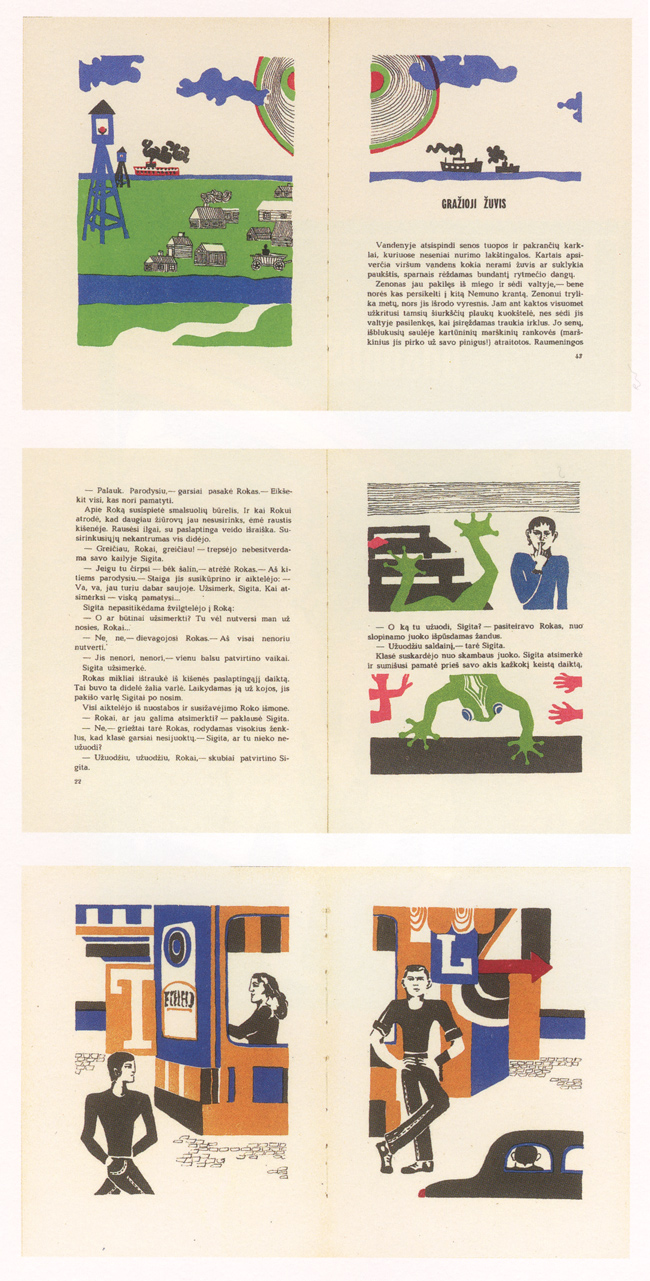 Teodora Každailienė, Where the Ships Hoot, 1970
Teodora Každailienė, Where the Ships Hoot, 1970
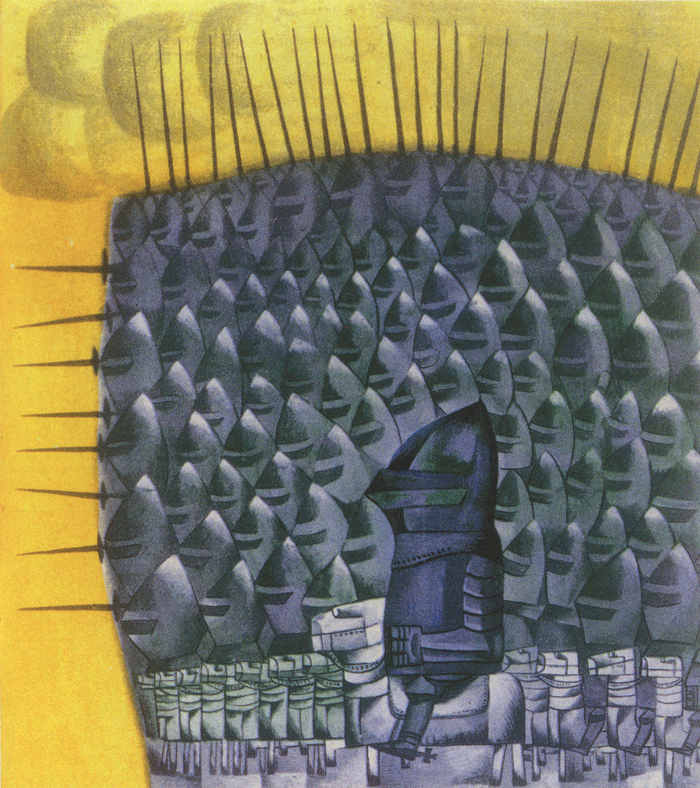 Lidija Glinskiene, Iron Fingernails, 1968
Lidija Glinskiene, Iron Fingernails, 1968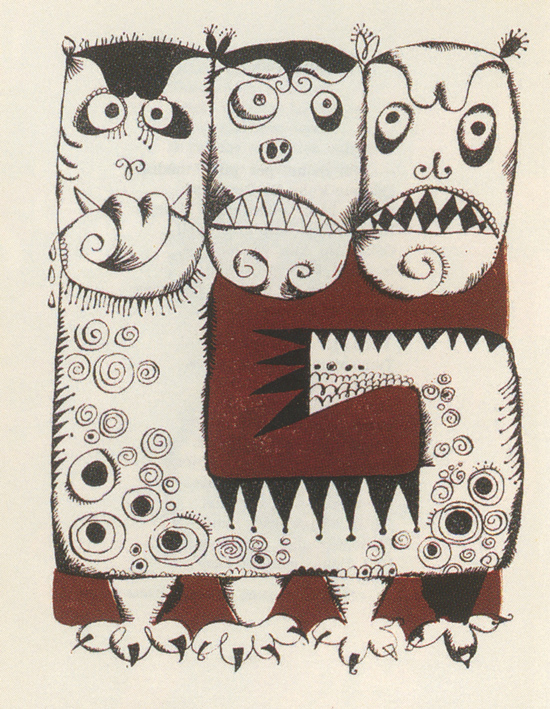 Lidija Glinskiene, Leine the Warrior, 1965
Lidija Glinskiene, Leine the Warrior, 1965 Aspazija Surgailienė, The Chest of Fairy Tales, 1961
Aspazija Surgailienė, The Chest of Fairy Tales, 1961
 Marija Ladigaitė, The Four Winds of Winter, 1963
"These illustrations are remarkable, not only for their modern form, but also for the intense mood of overwhelming sadness..."
Marija Ladigaitė, The Four Winds of Winter, 1963
"These illustrations are remarkable, not only for their modern form, but also for the intense mood of overwhelming sadness..."
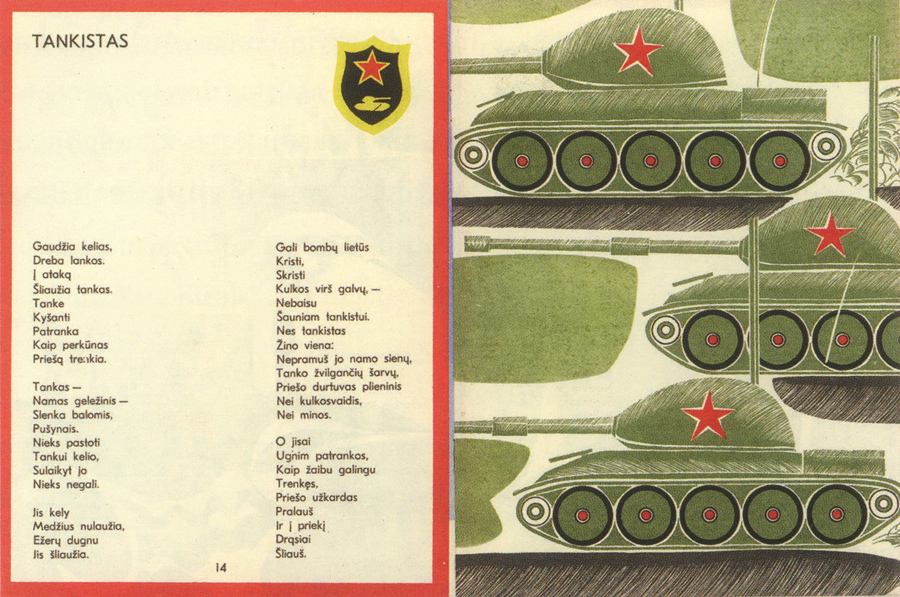 Kastytis Skromanas, Our Soliders, 1971
"An example of Soviet military propaganda..."
Kastytis Skromanas, Our Soliders, 1971
"An example of Soviet military propaganda..."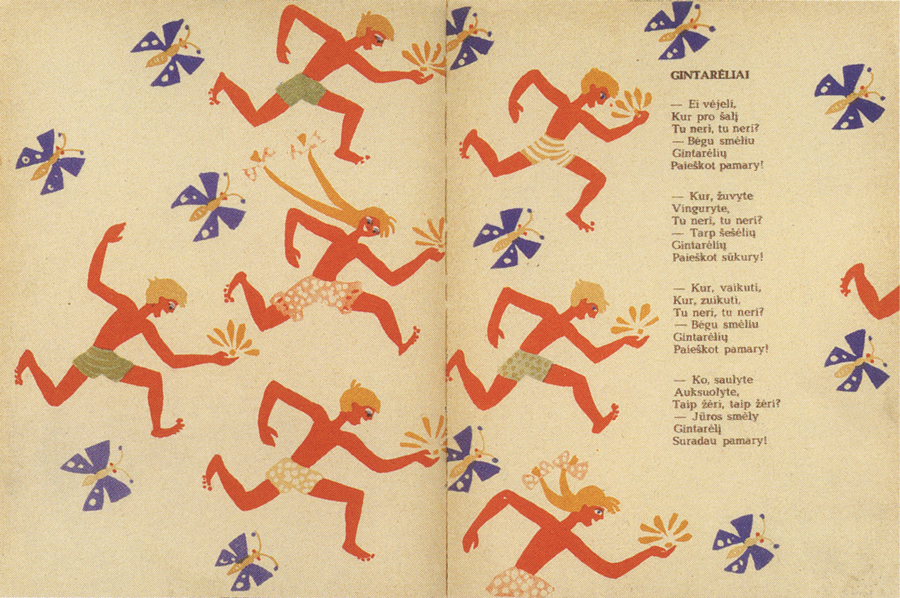 Rimtautas Gibavičius, Little Pieces of Amber, 1961
Rimtautas Gibavičius, Little Pieces of Amber, 1961
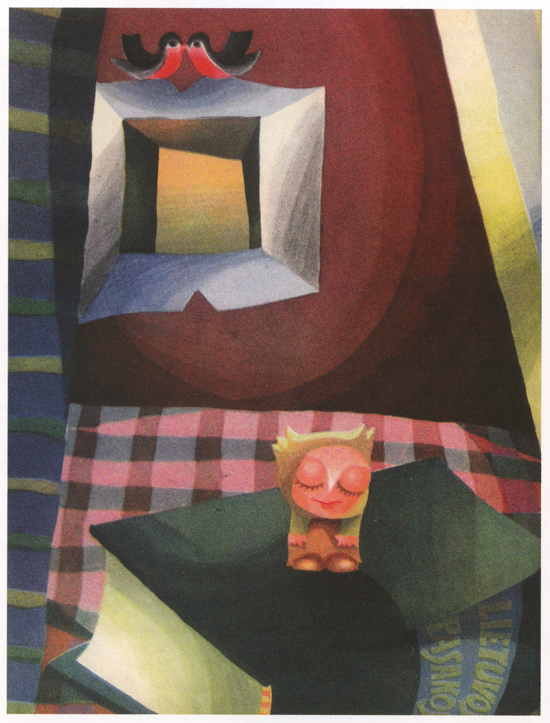 Marija Ladigaitė, The Little Owl's Dream, 1969
Marija Ladigaitė, The Little Owl's Dream, 1969
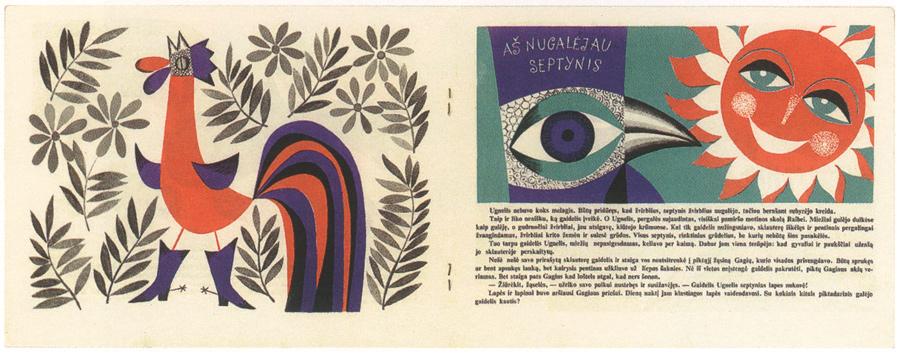 Lidija Glinskiene, Little Fire, Conqueror of the Seven, 1965
Lidija Glinskiene, Little Fire, Conqueror of the Seven, 1965 Arvydas Každailis, Our Cars, 1972
About the exhibit:The exhibits reveal what ideas and images were instilled in little readers, how they served the dissemination of Communist ideology and to what extent children were allowed to live in the child’s world of fairy tales, adventures and imagination.
The exhibition is broken into three parts corresponding to the three main stages in the history of Soviet Lithuania. The exhibits are arranged chronologically and according to four themes: the children’s book as a mouthpiece for propaganda, the children’s book as a means of sustaining the national identity, the children’s book as a “window to the West”, and the child’s world as it emerges in the illustration of children’s books. Originals of books and illustrations are on view, while the catalogue includes photographs from the period reflecting the lives of children and the atmosphere, and posters which accompanied children’s cultural life.
All Lithuanians who experienced a Soviet childhood keep memories of the legendary pair of artists Birutė Žilytė and Algirdas Steponavičius. Today we can discover a new relevance in work by artists who established themselves in the 1960s and 1970s. Steponavičius is the key to understanding the artistic world of the entire generation of contemporary book illustrators. He set a standard for the most talented of his generation and younger Lithuanian graphic artists such as Lidija Glinskienė, Petras Repšys, Aspazija Surgailienė. He was indirectly a teacher for Stasys Eidrigevičius, who matured as an artist in Lithuania before continuing his career after 1980 in Poland. Žilytė, Steponavičius, their contemporaries and younger artists represented the entire epoch of Lithuanian culture which emerges in this exhibition.
Thanks again to Rūta for her help! Also to Laura at Animalarium for turning me on to Illustrarium in 2011.
See all posts tagged "Lithuania"
This post first appeared on March 24, 2014 on 50 Watts
Arvydas Každailis, Our Cars, 1972
About the exhibit:The exhibits reveal what ideas and images were instilled in little readers, how they served the dissemination of Communist ideology and to what extent children were allowed to live in the child’s world of fairy tales, adventures and imagination.
The exhibition is broken into three parts corresponding to the three main stages in the history of Soviet Lithuania. The exhibits are arranged chronologically and according to four themes: the children’s book as a mouthpiece for propaganda, the children’s book as a means of sustaining the national identity, the children’s book as a “window to the West”, and the child’s world as it emerges in the illustration of children’s books. Originals of books and illustrations are on view, while the catalogue includes photographs from the period reflecting the lives of children and the atmosphere, and posters which accompanied children’s cultural life.
All Lithuanians who experienced a Soviet childhood keep memories of the legendary pair of artists Birutė Žilytė and Algirdas Steponavičius. Today we can discover a new relevance in work by artists who established themselves in the 1960s and 1970s. Steponavičius is the key to understanding the artistic world of the entire generation of contemporary book illustrators. He set a standard for the most talented of his generation and younger Lithuanian graphic artists such as Lidija Glinskienė, Petras Repšys, Aspazija Surgailienė. He was indirectly a teacher for Stasys Eidrigevičius, who matured as an artist in Lithuania before continuing his career after 1980 in Poland. Žilytė, Steponavičius, their contemporaries and younger artists represented the entire epoch of Lithuanian culture which emerges in this exhibition.
Thanks again to Rūta for her help! Also to Laura at Animalarium for turning me on to Illustrarium in 2011.
See all posts tagged "Lithuania"
This post first appeared on March 24, 2014 on 50 Watts


